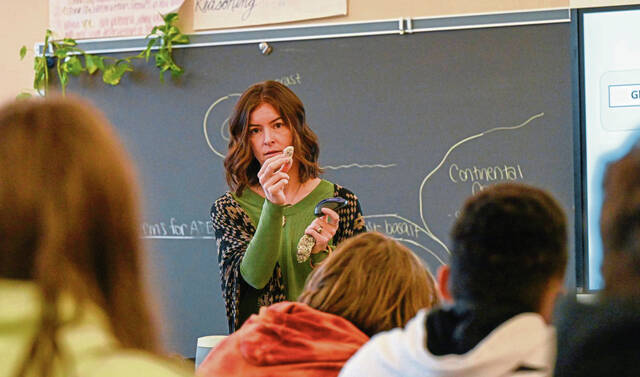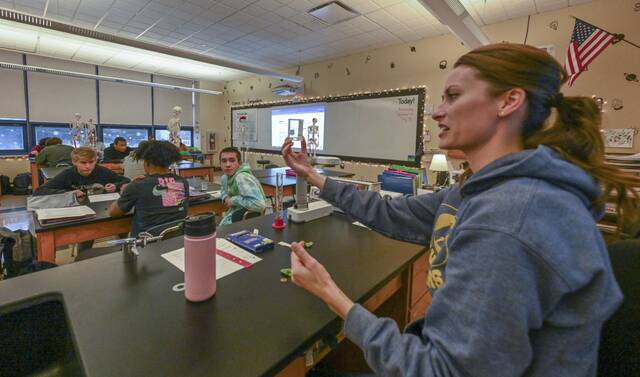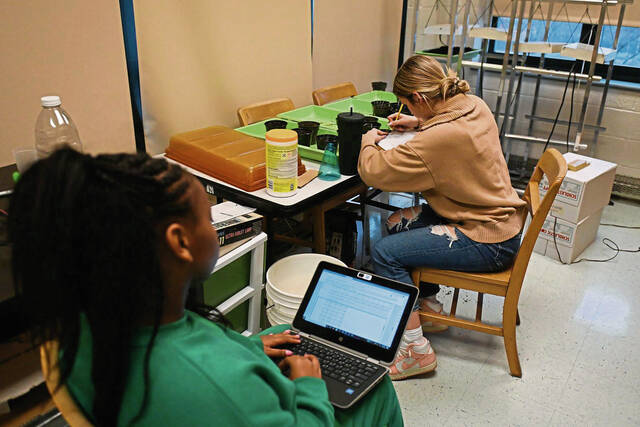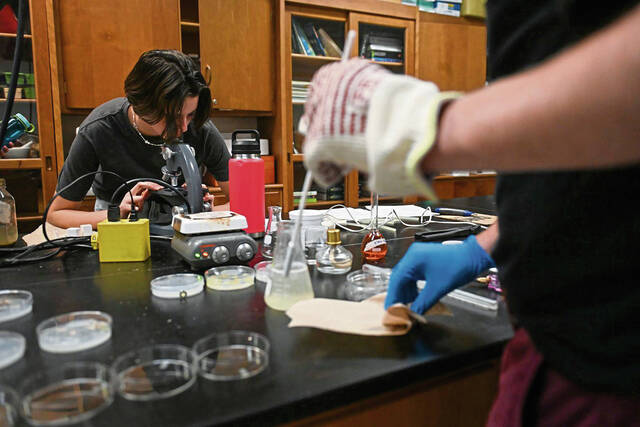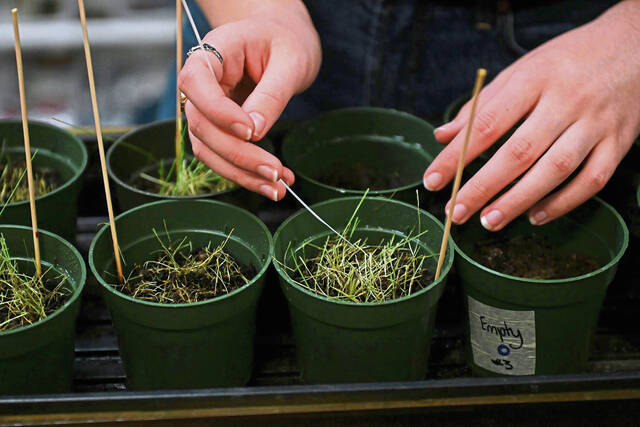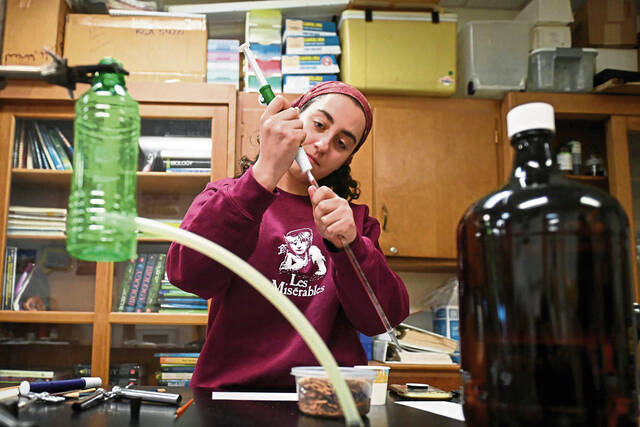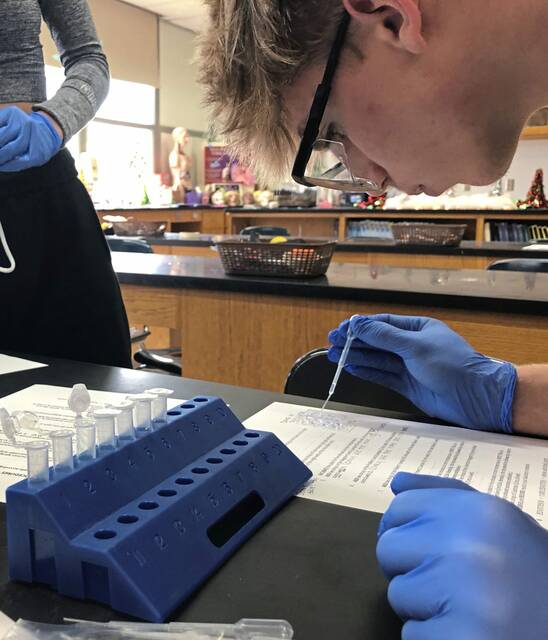Real-world events, from Mars rover to covid-19 to Artemis rocket, are shaping future scientists
For Alison Bresnahan, there isn’t a better time to be a science teacher.
From NASA’s Artemis 1 moon mission to the James Webb Space Telescope to the Mars Perseverance rover to even the covid-19 pandemic, significant real-world events are inspiring the next generation of scientists — even if they don’t know it.
And it all begins in classrooms like Bresnahan’s at Kiski Area High School.
“I’d say that now is the best time to be a science teacher,” she said. “It’s easy to engage students, and the resources are endless. Even if I am not teaching about a ‘big’ topic that’s in mainstream media, there’s always new science about it somewhere, and it’s even better if it’s local.”
The Artemis spacecraft is scheduled to splash down to Earth on Sunday. It was launched from Kennedy Space Center in Florida in mid-November, in order to test the Orion spacecraft, and specifically its heat shield, in preparation for crewed lunar missions.
NASA’s Webb infrared telescope was launched in December 2021 and will serve thousands of astronomers worldwide as it sends back images from deep space. NASA also is using a rover to collect information and material from the surface of Mars.
“We definitely look to incorporate current events into class any time that’s possible,” said Bob Capanna, who teaches eighth grade physical science at Kiski Intermediate School in Allegheny Township. “We cover a gravity unit at the end of the year, and I will absolutely bring the Artemis mission in as part of that.”
Engaging students
Years before the Artemis mission launched a spacecraft carrying manikins on a lunar orbit mission, students in A.J. Danny’s sixth grade science class at Franklin Regional Middle School already were working to develop items astronauts might take with them when the space agency sends a crewed mission to the lunar surface.
Danny’s students were among five groups to win the NASA Wear Challenge, where students were tasked with designing garments that would protect astronauts from ionizing particles while in space.
“We did some classroom activities to mark the 50th anniversary of the moon landing as well, and we’ve kept with it because there’s so much excitement around space missions like Artemis,” Danny said.
As his class was working on the Wear Challenge, they hit a snag when the covid-19 pandemic kicked into full swing.
But Danny and other teachers said that even something as devastating as the pandemic offers them a chance to bring real-world science into the classroom.
“This year, we talked about how new vaccines are tested, and I tried to relate that to how we design our classroom experiments,” Capanna said. “You control for variables and try to ensure your results are valid. We always try to tie in real-world lessons.”
Bresnahan said she will use the Artemis mission to help engage students when they begin a chapter geared toward lunar missions and space science in February.
In her environmental science class, however, there has been plenty of science in the news that she can use to show students how their lessons can be applied outside the classroom.
“Something like the COP27 conference and the climate talks with world leaders is a topic we’ve discussed, and it’s a class where current events come up much more often,” Bresnahan said. “I like to make sure and mention current events or science-related things that have happened, to try and encourage students to engage.”
Kiski Area junior Samantha Coleman said her teachers have pushed her to connect classroom science lessons with things happening in the real world. She took Bresnahan’s environmental science class her sophomore year.
“It made me go out of my way to learn more about climate change,” Coleman said. “It was cool to have a class that is really based in the world and how it works.”
Coleman said she wants to go into aerospace engineering after high school.
“I was always interested in space,” she said. “I can remember as a little kid, looking up at the stars and thinking, ‘What the heck?’ ”
Real-world connections
In the Quaker Valley School District, high school science teacher David Robertson was able to use data about the covid-19 pandemic to have his students explore a host of topics.
“We were able to use covid data to speak to a lot of biological phenomena, from evolution to health care,” he said. “I teach an honors research science class with about a dozen or so kids, and they’re doing their own research. It’s a great illustration of students using what they’re seeing in the real world, in the classroom.”
On Dec. 7, students in Monica Graziani’s human body systems class at Franklin Regional Senior High School were undertaking a lab that simulates a covid-19 antibody test. But instead of simply swabbing their nostrils and waiting for results, they were learning about the chemistry that makes the at-home tests so easy to perform and understand.
Graziani said she was excited to see the state Department of Education adopt an updated set of K-12 science standards in the spring that will focus on “phenomena-based” education.
“It works using prior knowledge that the kids have and uses real-world science to engage them in lessons,” she said.
The updated standards, which will go into effect fully with the 2025-26 school year, dovetail well with elements of Project Lead the Way, a hands-on, problem-based curriculum centered on using science, technology, engineering and math concepts, or STEM, to solve real-world problems. Franklin Regional officials adopted it starting in 2018 as an addition to their own science curriculum.
“It also uses real-world science to reinforce the lessons,” Graziani said.
‘More than a mindset’
Robertson said bringing in examples that students have seen in the news and pop culture “can help spur curiosity and questions, even in students who are not science-minded.”
“Science is more than a mindset — it’s a way of thinking about the world,” he said. “That’s the real ‘seed’ that needs to be planted in students to help foster a new generation of scientists.”
According to the U.S. Bureau of Labor Statistics, employment in the life-, physical- and social-science field is expected to grow by 7% by 2031, resulting in about 98,700 new jobs in the coming decade. That is in addition to about 147,900 job openings each year, projected to come from growth and replacement needs.
They range from food-science technicians, which has a median salary of $44,700, to physicists and astronomers, with a median salary of $147,450.
School districts also have made a push to integrate STEM components into more of their curricula.
Kiski Area’s Coleman said that focus has changed the makeup of her high school elective science classes.
“It’s way more balanced (between boys and girls) than I thought it would be,” she said. “From a younger age, STEM was really pushed on us, and I know, for me, I remember thinking as a girl that there’s no reason for me not to do this or be interested in it.”
Franklin Regional freshman Matthew Morcos, who was part of the NASA Wear Challenge team, said the integration of STEM concepts has had a noticeable effect on him.
“It opened my mind up to it a little more,” said Morcos, 15. “It definitely got me more interested in this kind of stuff. Now that I’m a little older, it’s not necessarily mentioned as much that we’re using STEM, but I can tell that we’re actually using it all the time and I think it has a big impact on the way we learn.”
Teachers also seek to encourage students when they see a spark.
“Last year, I ended up teaching about space for a month longer than usual because the kids were really interested in it,” Bresnahan said.
Patrick Varine is a TribLive reporter covering Delmont, Export and Murrysville. He is a Western Pennsylvania native and joined the Trib in 2010 after working as a reporter and editor with the former Dover Post Co. in Delaware. He can be reached at pvarine@triblive.com.
Remove the ads from your TribLIVE reading experience but still support the journalists who create the content with TribLIVE Ad-Free.

